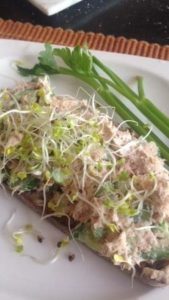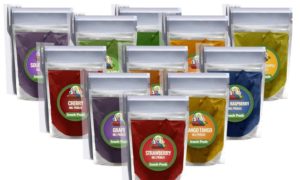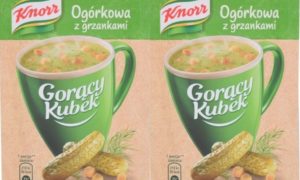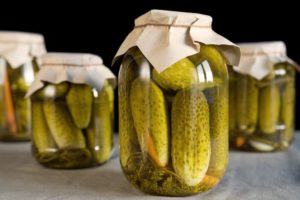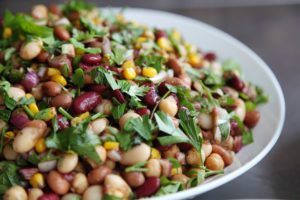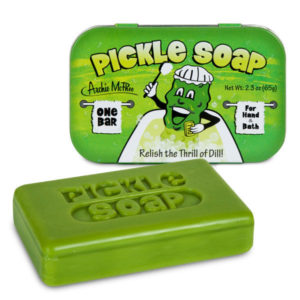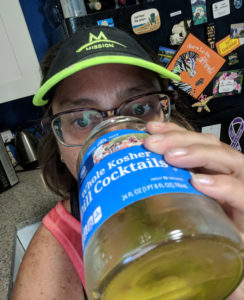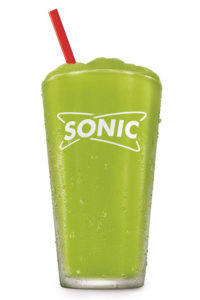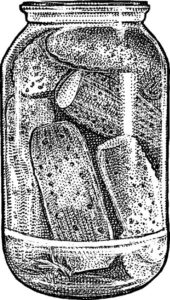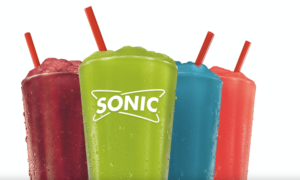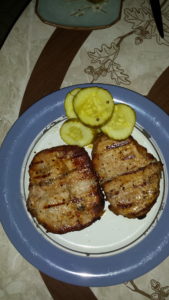By: Ryan Bradley
Eater

Illustrations by Chrissy Curtin
The chile looks a lot like a jalapeno and, well, it tastes like a jalapeno, too. But, you know, different. I first noticed it when I was eating the rice and beans at B.S. Taqueria downtown Los Angeles. The dish — the rice and beans — had a lot going on: The rice was puffed; the beans (white and garbanzos) were lightly fried. There were also grilled onions and cotija cheese, all served in a brown paper bag that quickly went wet with grease. But the chiles, they pulled the whole thing together, giving it a strange hint of sweetness, a tinge of smoke, and heat of course, a buzzy tingle and occasional pang. They never overwhelmed. They were very, very good. I was intrigued and, quickly, borderline obsessed. Why hadn’t I heard of a Fresno chile before?
Not long after that first encounter, I was talking to Ray Garcia, the chef-owner of B.S. Taqueria, who created the rice-and-bean dish. Fresnos are a “gateway chile,” he said — they’re friendly, easy to eat, both familiar and not. “People are like, ‘Oh! Fresnos! Yeah, I grow these! I grew up on these! This is, like, right before a jalapeno goes green, yeah?’” It is not. But it’s entirely possible you have encountered a Fresno, possibly in a supermarket, most likely mislabeled as a jalapeno. “No one knows what they’re talking about with Fresnos,” Garcia said, which seemed like it couldn’t be true. But, the more I looked into it, the more it turned out to be the case. Fresnos are right on the edge of familiarity: If you’d heard of them, you either had nothing to say about them, or what you did have to say was likely wrong. The chile was like the California city: a place you drove past and barely considered. Only, I wanted to consider it. I wasn’t even sure, starting out, if the city and the pepper had anything to do with each other.
They do. Sort of. Fresno chiles are named after Fresno, not the city, but the county in California’s central valley containing the city of the same name. They were developed in the 1950s by a local grower and seed merchant named Clarence “Brownie” Hamlin, who lived in the county of Fresno, in a town called Clovis, which is just outside the city of Fresno. The chile pepper Hamlin hybridized was, like all chile pepper plants, magnificently malleable. The chile pepper is a self-fertilizing plant, meaning the flowers on a single specimen contain both male and female genes. To crossbreed a pair of chiles, one plant has to be pollinated with the other. Swab the flower of one plant with a bee-like apparatus, perhaps a Q-tip, smear that across the flowers on the other plant, and boom, you’ve hybridized two peppers.
Okay, sure, it’s more complicated than that, since certain traits might show up in some peppers and not others, so there are seeds to save, and generations to cultivate, and traits to draw out through those generations, which is what Brownie Hamlin surely did to reach the variety he felt worth hanging onto and making an heirloom, the variety he named after the county he lived in and the town he lived near, the town at the center of the largest, most productive stretch of agricultural land on the continent, if not in the whole entire world.
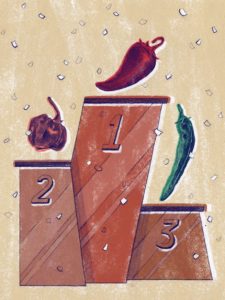
Illustrations by Chrissy Curtin
Hamlin’s nephew, Casey, also lives near Fresno and sells seeds, including those of the Fresno, which he describes on his company’s website as similar to jalapenos but with thinner walls, which makes them perfect for cooking, or in a salsa. When I tried to buy the seeds online, or contact Casey directly, I couldn’t. Links were defunct, my calls and emails unreturned. I contacted the Fresno Historical Society, as well as the Fresno agricultural board, and, for good measure, the University of California’s agricultural cooperative, which has a few stations near Fresno. No one had anything to say about the Fresno chile.
Meanwhile, I began seeking out Fresnos everywhere I could, which produced all manner of disappointment. Unlike a jalapeno, serrano, Italian, shishito, or a bell pepper, a Fresno isn’t a regularly stocked item. You couldn’t plan around a Fresno, couldn’t count on it being there. And yet it is very much like those other far more common peppers, all of which are variations of the same species, capsicum annuum. (Not to be confused with black pepper, or piper nigrum, which comes from southern India.) All chile peppers come from the Americas — most likely central Mexico, where the plant was first cultivated at least 5,000 years ago.
Once the Spanish arrived, the peppers crossed oceans, first to Europe and then, carried by the Portuguese, to Asia, via the Indian port of Goa. Centuries passed, generation after generation of peppers: cultivated, hybridized, and folded into the cooking of regions throughout the globe. Peppers travel well and keep easily. The capsicum is a hearty plant, and the fruit works nearly every which way: grilled, sauteed, pickled, or dried and crushed. When looking at the great sweep of the chile pepper’s history, the Fresno is a very recent arrival. But that still doesn’t fully explain its second-class status. What might is its heat, or lack thereof.Capsicums are unique plants — their fruit produces compounds called capsaicinoids, possibly, initially, evolutionarily, as a protective measure: to keep from being eaten. Capsaicinoids, you see, are what give the pepper its heat. The compounds aggravate and alarm our immune system. They make us feel hot and go sweaty. Humans, like peppers, are unique: Many of us find the experience of burning pain to be fantastic, excellent, delicious.

Illustrations by Chrissy Curtin
In recent decades, there has been a sort of arms race to hybridize ever-hotter peppers. In 1912, a Connecticut pharmacist named Wilbur Scoville developed the Scoville Organoleptic Test — a test for spiciness that involved progressive dilutions of a pepper’s extract into sugar water. The more dilutions required to minimize the heat to an imperceptible level, the hotter the pepper. And thus, the Scoville heat unit scale was born. A jalapeno requires about 5,000 parts water to one part chile extract to minimize its heat, so a jalapeno is around 5,000 Scoville heat units. A Fresno is about the same. A bell pepper is zero. The recently developed Bhut Jolokia is over a million SHUs. The Trinidad Scorpion is around 1.2 million. There is a very silly but also sort of fascinating debate as to which pepper is truly the hottest on Earth. On YouTube, there is a robust community of men (only men; mostly British) eating these peppers, going very red, weeping uncontrollably, falling on the floor, writhing, moaning, sweating, cursing, gasping, and bellowing. These are stunt peppers, not — if you are a sane and average person — for eating. The Fresno can’t compete.
Still, I wanted to track down some Fresnos, and find someone who could tell me something about them. I finally called Craig Underwood, a farmer who until recently grew all the jalapenos for Huy Fong Foods, Inc., makers of Sriracha, on 2,000 acres outside Ventura, California. He still grows jalapenos, as well as serranos and cascabels, but this year, he was putting in extra rows of Fresnos. “Way more than we’ve ever planted,” he yelled over the thrum of his pickup, piloting his way across his fields. His farm manager noticed that Fresnos were fetching pretty good prices down at LA’s 7th Street Produce Market, and Underwood wasn’t one to question what people wanted to buy. Maybe, he ventured, it was because in the fall, when the peppers turn red, their skin doesn’t crack the way a jalapeno’s often does. “People won’t buy a red jalapeno when it’s cracked,” he said with the confidence of a man whose trade is peppers. I asked Underwood if he thought there might be some growers still in Fresno, growing Fresnos. The community of pepper-growers in California was pretty small, he said, but he hadn’t heard of Brownie Hamlin or his nephew, and wasn’t sure about Fresnos growing in and around Fresno, which had lately turned to more lucrative crops, like almonds.
A few days after my call with Underwood, I decided to drive up to Fresno and find out for myself. Heading north from LA, up and over the San Emigdio Mountains, you first see the San Joaquin Valley from high above. If it’s early, which it was, clouds cling to the peaks as you drive by, and off in the distance, further east, nearly lost in the haze, are the Sierra Nevadas, still snowcapped in places, still holding the water that has fed this great valley since long before history, giving it some of the loamiest, richest soil on earth. The farmland begins even before the land levels out, continuing uninterrupted for some 450 miles. Fresno is smack in the middle. Some 85 percent of America’s carrots grow here, along with more than 90 percent of our raisins and almonds, around 95 percent of our processed tomatoes, and most of our walnuts, grapes, and pistachios, too. If you’re passing through the San Joaquin, you take I-5 (and, indeed, I usually do). But California State Route 99 cuts through the heart of the agricultural center and its cities. Driving the 99, it often seems like half the cars on the road are trucks laden with just-picked crops.
My first stop was a farm stand in Clovis, the town adjacent to Fresno and where Brownie Hamlin had first hybridized his chile seed. There I met Vincent Ricchiuti, great grandson of Vincenzo Ricchiuti, who first arrived in the Valley from Northern Italy in 1914. Vincent’s father, Patrick, runs P-R Farms, Inc., among the largest farming concerns in the valley. They grow peaches, plums, apricots, nectarines, apples, grapes, almonds, and olives. Vincent runs ENZO, an olive oil company; one of his olive oils is also made with crushed Fresno chiles. As it happened, he was just planting his field of Fresnos that morning, behind the building where he sold the oil.
Fresnos start the same as all the other peppers — after all, they’re technically the same plant, with different characteristics drawn out at different times in the life cycle. In Thai chiles, for example, the pepper begins green, as all peppers do. Then, the pepper turns a brownish color, and peaks in spiciness before eventually going red. Some recipes that call for Thai green peppers, or for Thai brown, or still others for Thai red — well, people think they are different peppers, but it’s the same exact pepper, just picked at different times throughout the season.
Across the street was a massive beige building, a packing plant for the family business. Behind the stand and store was a few acres of dirt, bounded on two sides by a housing development — enough space for nearly 11,000 chile plants. As we walked out toward the field, Ricchiuti described what it was that had drawn him to Fresnos, the only chile he used in any of his oils. He said that they were “nice and level” and “really approachable,” as well as “warm and inviting.” A spice that “doesn’t hit you in the face,” he said. Also, he added, his mother, “who does not like spice at all, puts it on her eggs all the time.” But the real reason he was planting all these Fresnos was because Fresnos had felt to him like a discovery, or a rediscovery — a re-evaluation of the place he was from and called home.
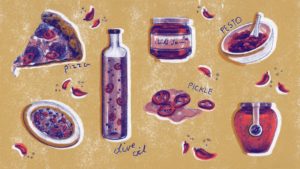
Illustrations by Chrissy Curtin
”It’s the most quintessential Fresno thing,” Ricchiuti said, squinting as he looked out over his field of chiles. “Here’s this beautiful food, named after us, but we’re not celebrating it, we don’t even know about it. It’s like a complex we’ve got: We’re not LA, we’re not San Francisco, and we’re reminded of that, often.” We walked along the rows of peppers for a stretch in silence. I had to admit, the plants didn’t look like much quite yet, just a few green shoots springing up out of the nearly black soil. “You got to go over to see Kong’s farm,” Ricchiuti said, breaking the silence. “That’s who got us set up here, because we’re not vegetable growers, really. But Kong, man, he’s growing the best vegetables in the country. I mean, Thomas Keller is flying his stuff to New York. Go see Kong. He’ll tell you what’s what. I think he’s got some Fresnos going in, too.”
An hour later, I arrived outside a small black gate, the entrance to Thao Family Farms, where Kong Thao met me and led me back to the 34 acres he and his parents and some of his 10 siblings farm. He smiled a rakish smile and asked if I was the guy who wanted to talk chiles, and then trudged off toward a patch of freshly tilled earth where his Fresnos had just gone in. “This is just a very small part of what we do,” he said, gesturing toward the patch. Beyond it were a dozen varieties of bell peppers, followed by dense rows of Italian long sweet peppers, Thai chiles, then arugula, tendrils of bitter melon, chards, collards, yu choy, bok choy, amaranth, blue spice basil, broccoli, Asian sorrel, Vietnamese coriander, chayote, several dozen varieties of heirloom tomatoes, 10 varieties of eggplant, six of summer squash, four of cucumbers — “a little bit of everything,” Thao said, eventually, giving up on listing it all.
Thao liked the Fresno chile’s complex flavor, but the reason he’d started growing it was even more basic than taste: “Vince and I, we’d been talking about it a few years, and finally we were like, ‘Let’s just do Fresnos, because we’re from Fresno.’” The taste of a pepper isn’t merely influenced by when it’s picked, but where it’s grown, so the Fresno has a different flavor when it’s grown in Fresno than anywhere elsewhere — farther north up the Valley, or along the coast, where growing seasons were longer. The peppers in those places get larger, but the flavor also gets diluted, according to Thao. In Fresno, the peppers were more compact, oily, and flavorful.
Thao mentioned a local chef named Jimmy Pardini, who also used his Fresnos, sometimes in salads, or on his pizzas. He came by the farm at least once a week to pick up some produce. It used to be, Thao would deliver directly to Pardini’s restaurant, the Annex Kitchen, but now Thao spends at least three days a week driving down to the farmer’s markets in Santa Monica, Hollywood, and Torrence, so he doesn’t have time anymore. Pardini was another one of the few locals who seemed to know about and like Fresno chiles. Maybe I should go talk to him?
Pardini’s restaurant was, as its name suggested, annexed from his family’s banquet hall and catering company, which they’d owned and operated for two generations. The space had been a diner — it still had the long counter with the kitchen right behind it, but now a pizza oven and huge wood grill dominated the entrance. A stack of almond wood from the Ricchiuti family orchards sat next to the grill. Fresno is a small place.
Like Thao and Ricchiuti, Pardini had grown up in Fresno, but he didn’t learn about Fresno chiles until after college, working the line at Osteria Mozza, Nancy Silverton’s LA restaurant. The pepper was in a linguine with clams. “I was like, ‘Fresno Fresno? Where I’m from? I know there’s, like, a Fresno in Mexico? Is that the town?’” It was hard to believe this pepper, showing up in this fancy restaurant in the big city, was from his humble home. It had to be something more exotic. But it wasn’t. It was Fresno, Fresno.
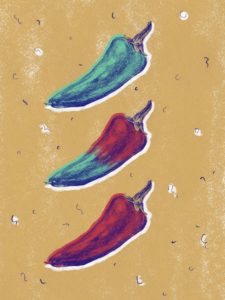
Illustrations by Chrissy Curtin
Later, I asked Silverton about the ways she uses the chile, what makes her like Fresnos as an ingredient, and what might have made Pardini first notice it. “Well it’s a beautiful chile, and when cooked there’s almost like a sweet kind of smoky note that it takes on,” she said. She slices it thin and chars it in the wood-burning oven and puts it on her salami pizza. Pickled, she adds it to braised chicken and sausage. Raw, she slices it into very thick rounds and, with a jalapeno, adds them to her spicy bean salad. There’s also a pesto she makes with Fresno chiles, for pasta.
The conversation turned to the Fresno’s provenance. She knew they were named after the city, but not much more than that. “It’s a newcomer, right?” Silverton ventured. Perhaps that was part of the problem, why it hadn’t found much of a foothold beyond chefs. It was new, as far as food goes. It didn’t have a tradition, or much of a story. “It’s a little lost soul,” she said, wistfully.
Pardini told me something similar, that although the pepper had a place, was named after a place, it kept falling through the cracks. “Each ethnic group has their chile,” he said. Italians long for the Italians, Armenian peppers for the Armenians, Thai chiles for the Thais, a whole universe of peppers for the Mexicans, he explained. In California, he continued, everyone had a friend — or an uncle, most likely — who had the peppers he grew in his backyard, the peppers he’d brag about over the grill in the summertime, and those peppers, passed down from generation to generation, were almost never Fresnos. We were, after all, a nation of immigrants, and peppers travel well. Even when a pepper came from here — even though all peppers come from this continent — we are loyal to the past, to the peppers we’ve known, that our ancestors had brought along.
But the Fresno chile can have a story, too. What’s nice about newcomers is that their story hasn’t been fully written, and can be yours to write. A few days after my trip to Fresno, I was at a nursery near my home, and there, beside the jalapenos and serranos, near the rows and rows of tomatoes, was a single Fresno chile plant in a tiny plastic pot. I took it up to the register, and the woman behind it couldn’t find the price anywhere. She thought it might have been a mistake, this plant’s arrival and existence in the nursery. That it had gotten mixed in with the other, more standard chiles. She sold it to me for a dollar and the next day, I planted it. There is at least one pepper growing on it now, small and green. But by the time you read this, maybe it will have started going red. And soon enough, it will be fall, and I’ll cut it open and carefully take out its seeds, saving them for next year. Then maybe I’ll pickle the rest of it, or make it into a jelly. I’ll have friends over to try some and I’ll probably tell them, yes, it comes from Fresno. But like all peppers it comes from elsewhere, too. It’s a hybrid. It’s a newbie. It’s a great American pepper. And isn’t it delicious?


